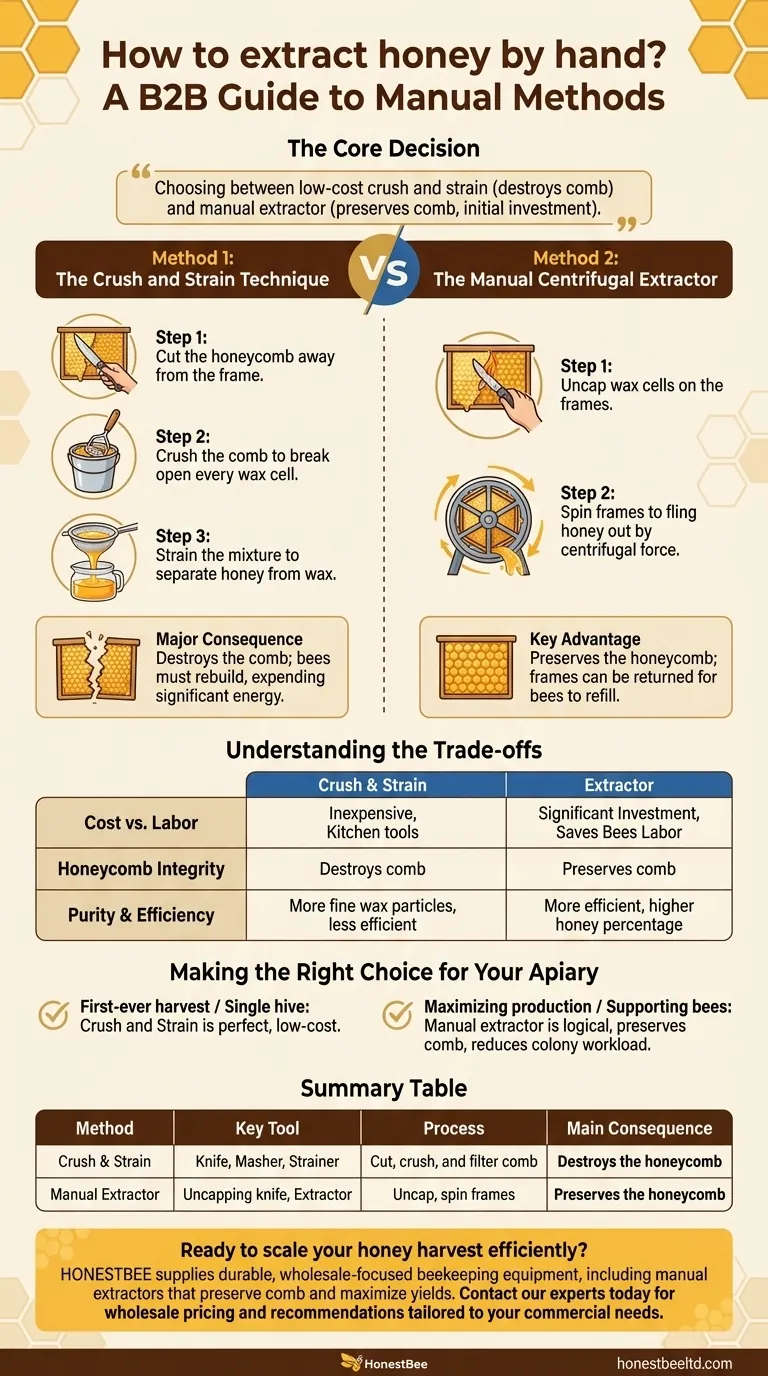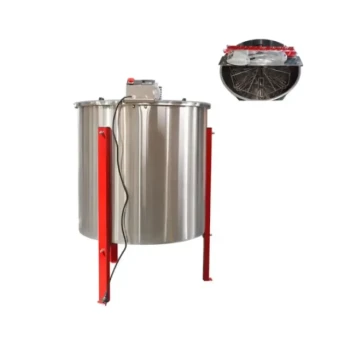The simplest way to extract honey by hand is through the "crush and strain" method. This technique involves cutting the honeycomb from its frame, physically crushing the comb to release the honey, and then straining the mixture through a filter or cloth to separate the liquid honey from the solid beeswax.
The core decision in manual honey extraction is choosing between the low-cost crush and strain method, which destroys the honeycomb, and using a manual extractor, which preserves the comb but requires a greater initial investment.
The Principle: Separating Honey from Wax
All honey extraction, whether manual or mechanical, is about one thing: separating honey from the wax comb bees build to store it. Bees seal each cell of honey with a wax cap. The first step is always to remove these caps. After that, you must choose a method to get the honey out of the cells.
Method 1: The Crush and Strain Technique
This is the most direct, low-tech method and requires minimal specialized equipment, making it ideal for first-time beekeepers or very small-scale operations.
Essential Tools
You only need a few basic items: a knife to cut the comb, a large food-grade bucket or bowl, a tool for crushing (like a potato masher or dough cutter), and a strainer, sieve, or cheesecloth for filtering.
The Step-by-Step Process
First, use a knife to carefully cut the honeycomb away from the frame. Place the comb into your bucket.
Next, crush the comb thoroughly. The goal is to break open every wax cell to release the honey.
Finally, pour the mixture of honey and crushed wax through your strainer or cloth into a clean container. Gravity will do the work, but it may take several hours for all the honey to drip through.
The Major Consequence
This method destroys the comb. Your bees must expend significant energy and resources (consuming about 8 pounds of honey to produce 1 pound of wax) to rebuild it from scratch.
Method 2: The Manual Centrifugal Extractor
A manual extractor is a drum with a crank that uses centrifugal force to pull honey from the combs. While it's a piece of equipment, it's operated entirely by hand.
How It Works
You begin by slicing off the wax cappings with a heated knife or uncapping scratcher. The frames are then placed inside the extractor's basket.
As you turn the crank, the frames spin rapidly. This motion flings the honey out of the cells and onto the inner wall of the drum, where it drips down to a collection gate at the bottom.
The Key Advantage
The primary benefit of an extractor is that it preserves the honeycomb. You can return the empty frames to the hive, giving your bees a massive head start on refilling them.
Understanding the Trade-offs
Choosing a method is not about right or wrong; it's about what fits your scale, budget, and philosophy.
Cost vs. Labor
The crush and strain method is extremely inexpensive, relying on common kitchen tools. A manual extractor is a significant investment for a hobbyist, but it dramatically speeds up the process and saves the bees labor.
Honeycomb Integrity
As noted, crushing destroys the comb, forcing the bees to rebuild. Preserving the comb with an extractor allows the colony to focus its energy on foraging and making more honey, often leading to a larger harvest in the long run.
Purity and Efficiency
Both methods produce excellent honey. However, crush and strain can introduce more fine wax particles, requiring more thorough filtering. An extractor is generally more efficient at removing a higher percentage of honey from the comb.
Making the Right Choice for Your Apiary
Your goals as a beekeeper should guide your decision. A little forethought ensures you choose the process that best suits your needs.
- If your primary focus is your first-ever harvest or a single hive: The crush and strain method is a perfect, low-cost way to get started and enjoy your honey.
- If your primary focus is maximizing honey production and supporting your bees: Investing in a manual extractor is the most logical step to preserve the comb and reduce the colony's workload.
Ultimately, extracting honey by hand is a rewarding process that connects you directly to the work of your hive.
Summary Table:
| Method | Key Tool | Process | Main Consequence |
|---|---|---|---|
| Crush & Strain | Knife, Masher, Strainer | Cut, crush, and filter comb | Destroys the honeycomb |
| Manual Extractor | Uncapping knife, Extractor | Uncap, spin frames to fling honey out | Preserves the honeycomb |
Ready to scale your honey harvest efficiently?
For commercial apiaries and beekeeping equipment distributors, the right tools are not a luxury—they are essential for productivity and bee health. HONESTBEE supplies durable, wholesale-focused beekeeping equipment, including manual extractors that preserve comb and maximize long-term yields.
Let us help you choose the perfect equipment for your operation. Contact our experts today for wholesale pricing and recommendations tailored to your commercial needs.
Visual Guide

Related Products
- HONESTBEE 3-Frame Manual Acrylic Honey Extractor
- Electric 8 Frame Honey Spinner Extractor Equipment for Beekeeping
- Stainless Steel 3 Frame Manual Honey Extractor Spinner for Bee Honey Extraction
- 2 Frame Stainless Steel Manual Honey Spinner Extractor for Beekeeping
- electric honey extractor honey centrifuge 3 frame honey extractor stainless steel honey frame extractor
People Also Ask
- Which type of honey extractor is generally more durable? Focus on Material & Build Quality for Longevity
- How often do beekeepers collect honey? Maximize Your Hive's Sustainable Yield
- What equipment is used for honey harvest? Essential Tools for Every Beekeeper
- What is the most common method for cleaning a honey extractor? Protect Your Honey & Equipment
- What machines are needed in beekeeping besides basic tools? Scale Your Honey Harvest Efficiently



















